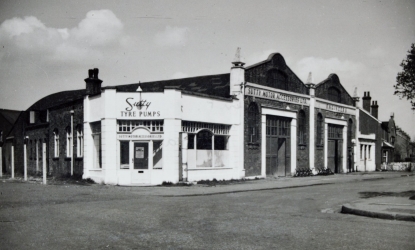


FARNBOROUGH VILLAGE TOUR
Dolly Anderson (nee Baldwin), then of Beechwood Ave Farnborough, spoke at Newstead Woods Girls School in about 1997. These notes are developed from a transcript of her talk, and present an interesting overview of some of the changes in the village that she had witnessed since she was a child
Some of the buildings referred to have their own page on this site, that can be found on either the Locksbottom or Farnborough menus.
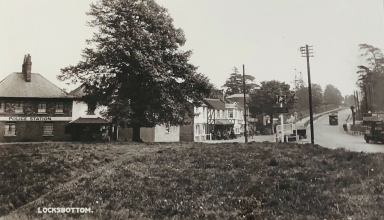 |
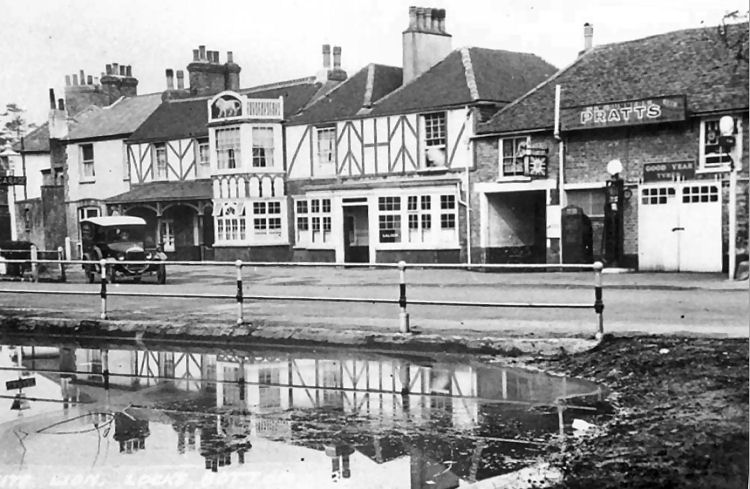 |
| Police Station, Whyte Lion and Goddendene | Ye Olde Whyte Lion |
You no-doubt wonder why I should talk to you about "Our Village'. Well, I was born and bred here, my family have lived and worked here for many generations. In 1736 the inhabitants of Farnborough, 4½ miles South-east.of Bromley, numbered 553. I wonder how many thousand people live here today?
The families were all inter married, .so I am related distantly to many local families i.e., the Weatherleys, Alchornes, Sessions, Stows, Picketts, Olivers, Goodchilds and the lord knows who else! The Baldwins ran the General Stores; the Thatchers, the Post Office, and the George & Dragon. The Goodchilds’ lived at the Woodman, the New Inn (now Change of Horses) and the British Queen. Grandmother Goodchild's father was Dr. Fowler, (who lived next to the Limes Laundry) Physician & Surgeon, during the late 1800s.
Farnborough Police Station opened in 1839. (Population of Farnborough1003) The building was previously a Dame School, then a butchers shop. In 1940 a plaque was placed on the wall to commemorate the formation of the 52nd Battalion of the Home Guard. This was removed and taken to the Orpington Museum, when the Station was closed and the building sold.
Legend has it that Sir Robert Peel, Chief of the Police, had a friend living at Farnborough Lodge, which is opposite the police station. The main road from London to Hastings (A21) passed near by with plenty of highwaymen lurking from time to time and he was rather worried for his friend's safety. The legend also has it, that he requested the police station to be built, to safeguard all travellers.
The Whyte Lion dates from approx. 1626. It was a Coaching Inn and the horses were watered at the pond opposite. If it was necessary to stay overnight they were fed and acconodated in the attached stable, which, much later, was turned into Pratt’s garage. Hearsay has it the bars are haunted by a lady smelling of lilacs, passing through, although I doubt if anyone has ever seen her.
Next to the Whyte Lion is the March family residence. All of them were sculptors, 6 brothers and 1 sister. Only Sydney March married, he had one daughter, a friend of mine, who was an artist. Unfortunately she died last year. They produced many memorials in bronze, the largest in world being the Canadian War Memorial in Ottawa. Another one is in South Africa and many memorials the world over. Their house was called Goddendene which was demolished to make way for the new Sainsbury’s supermarket.
The hill going up towards Farnborough is "Union Hill", so called as it passed by the Union Workhouse, which is now Farnborough Hospital. The 2nd turning on the left past the hospital is Hildavale Road, where John Alderton, a market gardener, formed the Farnborough Aviation Works in 1909/10 and his first plane is now in Hendon museum.
The village pump was beside "Brook Cottage" on the left going towards the village. There is a triangular green and at the rear stood the pump and it remained there until a few years ago when the council dismantled it for cleaning etc during which it miraculously disappeared.
Poplar Cottages between Brook House and the Cedar's Laundry were four very old wooden cottages in a terrace, dated around early eighteen hundreds. They have however lost their conservation value as they have been updated and modernised. Opposite on the grass verge is a mile stone which reads14 miles to London.
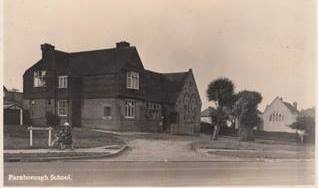 |
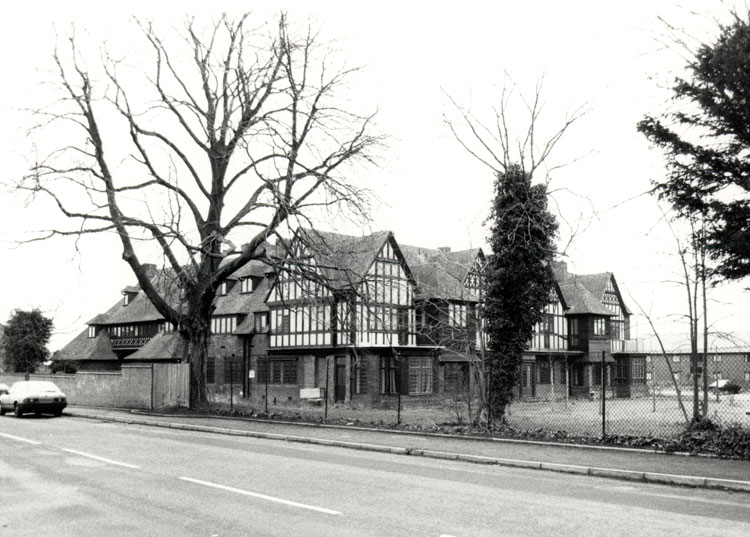 |
| former Village School | Bassets House |
As you approach the beginning of the village, coming from Bromley, after passing the Cedar's Laundry, (now demolished and replaced by new houses), you would see several weeping willow trees, behind which Farnborough Board School was built in 1873. The Fox brothers and the Weatherlys raised a mortgage to pay for the original building. The boys playground was around the Willow trees.
At the top of Starts Hill was the lovely Elizabethan mansion 1558/1601. It was a general arable farm in days gone by owned by the Bassett family. John Lovibond married their daughter Mada, hence we have Lovibonds Avenue, Mada Road, Bassetts Way, etc. The house was replaced by the present one in 1899 owned by Mr Neville Lubbock. In 1933 the house was taken over by a private boys school from Orpington, named “Westfield School”. During the 2nd World War it was used by doctors and other staff from Guys Hospital who worked in Farnborough Hospital and since it has been refurbished and is delightfully kept by the London Borough of Bromley Area Health Authority. In the grounds, to-day, are several bungalow type buildings for certain social services and some slightly mentally retarded folk.
Darrick Wood House I believe belonged to Crofton Manor and my recollection of the place is it was a home for the Army Band School, They were marched to Farnborough school every day and back again for lunch. On Sunday afternoons they attended a church parade at St. Giles.
As you approach the existing Village Main Road there was a huge post in the centre of the rough road, requesting traffic to “Go Slow Through the Village” to prevent too much dust. The first shops were wooden, when one entered the door, if you turned into the right room you were in the barbers shop, if you went left you were in a sweet shop. The original Chemist Shop was in the same parade, run by a Mr Snow.
After passing Nile Cottages you now come to Matthews Butchers. Originally on this site, I understand, was "The Coach & Horses" pub, with a pond for watering horses, abutting the road. Commonly referred to as "Old Mother Penfold’s Pub" by locals. After Mr Matthews retired the business was purchased by a Mr & Mrs Smith, their two daughters were roughly my age. Their grandson runs a very successful business there to day.
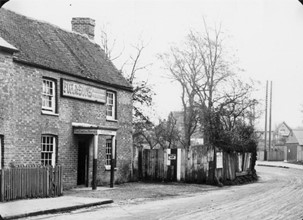 |
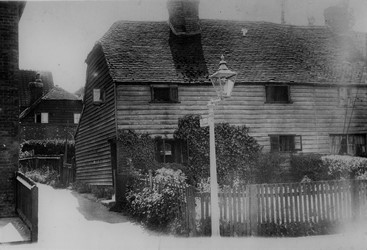 |
| former Coach and Horses | original Pleasant View |
Opposite was Chapman's Farm & Session's Farm. Today it is known as "Viners Farm". The double fronted house between "Viners" and the Scout Hut was originally called "The New Bakery". This was because, when the A21 was cut through at the School Green, Mr Fuller's Bakery was demolished and the up to date shop opened in the High Street.
Come along to the corner of "Pleasant View" there is a very nice bungalow, well, originally, behind it, were three wooden cottages, very old, but kept in good condition for the early thirties. Along Pleasant View are two very old cottages, around 1700, I would guess. Further up is the red tiled Victorian home of the Alchorne family, several other small dwellings, the Ex Servicemen's Club, and a public footpath through to Tye Lane. At the left hand side as you approach Pleasant View, is an old double fronted house, which was originally Mr Follett's Grocers Shop.
Opposite was the Limes Laundry which was owned by the Ballard family. Mary Ballard married Arthur Goodchild’s son, from the Woodman. They were going to emigrate on the Titanic to set up home in Vancouver, but fortunately as it turned out the liner was over crowded and they were referred back to the next voyage. Of course you know the Titanic sank after being in collision with an iceberg with very many lost.
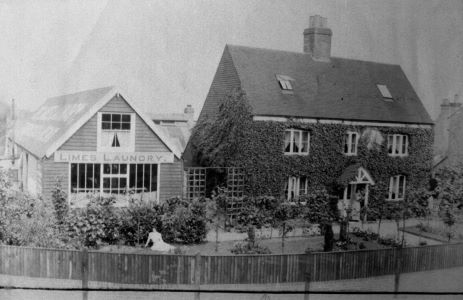 |
|
| Limes Laundry | Village Hall |
Almost next door dwelt Dr Fowler, Physician & Surgeon, who married Mr Goodchild the proprietor of the "Woodman". They had several sons & daughters. My Uncle Charles Goodchild & Aunt May kept the "New Inn". Opposite was the "New Inn Field", which is now referred to as the recreation ground, and apparently when the horse drawn coaches arrived from London they were provided with a cooked breakfast, carried across the road and served to the customers from long trestle tables. I was told by my parents as many as 180 breakfasts were sold on any hot summer's day.
Next to the field was Mr Rainey's garage, which is now the business place of Hartley and Dark. Going back to opposite the Woodman was the Parish Room, referred to these days as the Village Hall. This was built in 1897 by W.Owen a local builder, and designed by Mr George St Pierres Harris, Architect whose (almost) trade mark was the monument on the roof of any building he designed. I believe it was taken down a few years ago.
Next door was the Wesley Chapel, a small corrugated iron building, referred to as the "Tin Chapel", where they had many sewing & knitting classes for the younger folk during the winter evenings. Next to the Chapel was Green Gardens. Many allotments which were tilled by the villagers. Next, divided by a right of way , was the "Cosy Nook Tea Rooms" kept by the Wells family. It was a great haunt for cyclists who flocked in their droves to Farnborough, the New Cross Wheelers, the Catford Wheelers and many more. Visitors from the 47 bus terminus, at Church Road, use to go there for tea strawberries & fresh cream 6d-(2½ p).; Of course,
Close by was the village pond; that has now been done away with, and we have the Ladycroft housing estate. The roads are Green Gardens and Ladycroft Way, named after the field behind the swings and roundabouts, used now by the Sports Club. There was a very marshy pond near the hedge, but I think that has been filled in. On the long straight piece of the field was the local football pitch, where all the boys who were interested played each Saturday.
The Two Elms, a large house built around the 1600's, opposite Church Road, was the family residence of Grandfather Stow who was the Fire Master. My dad used to tell me of word coming of a house on fire and the rocket would be sent up. The old fire engine was always kept full of water but the horse was in the paddock, which was at the corner of Gladstone Road, as we know it to-day. Old Grandfather Stow apparently had to rush around, chasing the horse to catch it to put into the shafts of the fire engine. By the time he had achieved that the old boy was almost as red as the engine. Dad used to laugh, saying it was rather like the old "Rob Wilton storey"
Father used to refer to Gladstone, Peel, Pitt & Cobden Roads (named after various prime ministers) as the building field, because they were the really modern/villas of the day.
Where Coates Bros are now on the left as you enter Gladstone Road (now dwellings) was a huge iron constructed building.
There was a boot repair shop where Tubbs is now, Mr Whiffin's sweet shop, the dairy, paper shop, gentleman's outfitters & haberdashers, which was Mr Crafter's then Mr & Mrs Moodie, Mr Wallis the butcher and the Temperance Hotel - commonly known as "Old Mother Savage's Cook Shop". The front room over the shop was kept as a dentist, he came from Orpington on Thursday afternoons to attend to folk. The rest of the road to Tubbenden Lane was orchard belonging to "The Shruberies” big house at the corner which has been demolished with a view to the construction of flats, doctors surgery and clinic. This I understand has been rejected!!
Dolly Anderson c 1997
